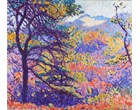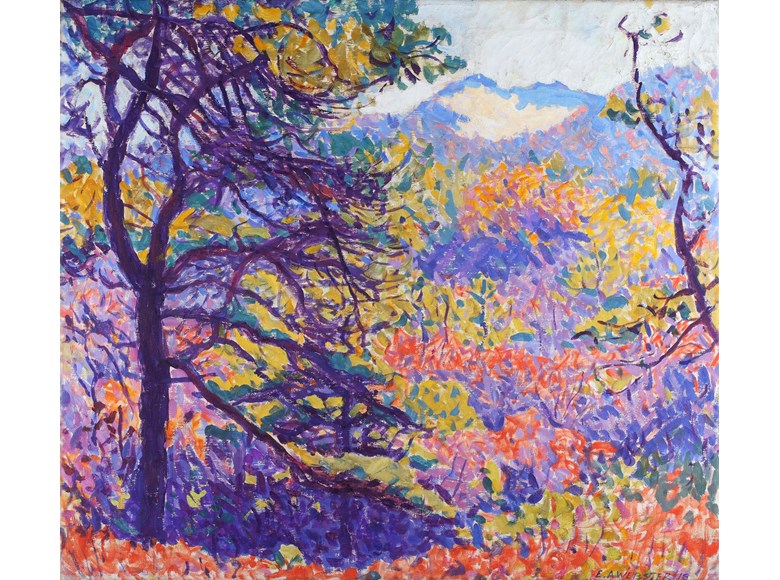 BACK TO GALLERY
BACK TO GALLERY
Avery Galleries
E. Ambrose Webster
Landscape
Signed and dated lower right: E. A WEBSTER '18
30 x 34 inches (76.2 x 91.4 cm)
description
E. Ambrose Webster was a well-known painter in his day and a founder of the Provincetown Art Colony. He was considered a leading modernist in America during the 1910s and exhibited in the 1913 Armory Show, the massive exhibition that introduced modern European artists to Americans in a large number.
Born in Chelsea, Massachusetts, Webster studied at the Boston Museum School under Edmund Tarbell and Frank Benson. As both Tarbell and Benson were graduates of the Academie Julian in Paris, they tended to send their students there for an exposure to European culture and aesthetics. Webster studied in Paris and traveled in Europe from 1896 to 1898. His exposure to both historic and avant-garde art while he was there was critical to his artistic development.
Upon his return from Europe, Webster settled in Provincetown and established the art colony there in 1900. The area appealed to Webster because of the quality of the marine light at the tip of Cape Cod. He painted outdoors and was an attentive observer of nature. He was thrilled by the effects of light and color and believed that both needed to be considered together. “We live in a world of color,” he wrote, and “a world without color would be a world without light, because color and light are inseparable.” He further asserted that “the eye sees what the brain knows to be true . . . there is nothing haphazard about color, and when its laws are understood the painter can go to his work in a direct way, without fumbling.”
Webster’s engagement with color stemmed from his study of the work of Henri Matisse. The French artist was an important early influence on Webster and had a profound impact on his understanding of light, shade, and color. Matisse, Webster claimed, was “one of the greatest Moderns,” not only “(because) he makes color live as color,” but also because he understood how to handle the contrasts of black and white. Webster followed Matisse’s dictum, that “a picture is like a game of cards: you must figure from the very beginning on what you will have at the end; everything must be worked backwards and always be finished before it is begun.” By instinct, inclination, and inspiration, Webster had a natural ability to follow Matisse’s advice: determine the palette and let the painting emerge from that.
Landscape of 1918 is a wonderful example of the Fauvist-inspired landscapes that defined Webster’s mid-career. Here the color is explosive and glorious; it invigorates the composition and enlivens the landscape. The assuredness of Webster’s technique and his command of his singular style make Landscape one the artist’s finest paintings.
Born in Chelsea, Massachusetts, Webster studied at the Boston Museum School under Edmund Tarbell and Frank Benson. As both Tarbell and Benson were graduates of the Academie Julian in Paris, they tended to send their students there for an exposure to European culture and aesthetics. Webster studied in Paris and traveled in Europe from 1896 to 1898. His exposure to both historic and avant-garde art while he was there was critical to his artistic development.
Upon his return from Europe, Webster settled in Provincetown and established the art colony there in 1900. The area appealed to Webster because of the quality of the marine light at the tip of Cape Cod. He painted outdoors and was an attentive observer of nature. He was thrilled by the effects of light and color and believed that both needed to be considered together. “We live in a world of color,” he wrote, and “a world without color would be a world without light, because color and light are inseparable.” He further asserted that “the eye sees what the brain knows to be true . . . there is nothing haphazard about color, and when its laws are understood the painter can go to his work in a direct way, without fumbling.”
Webster’s engagement with color stemmed from his study of the work of Henri Matisse. The French artist was an important early influence on Webster and had a profound impact on his understanding of light, shade, and color. Matisse, Webster claimed, was “one of the greatest Moderns,” not only “(because) he makes color live as color,” but also because he understood how to handle the contrasts of black and white. Webster followed Matisse’s dictum, that “a picture is like a game of cards: you must figure from the very beginning on what you will have at the end; everything must be worked backwards and always be finished before it is begun.” By instinct, inclination, and inspiration, Webster had a natural ability to follow Matisse’s advice: determine the palette and let the painting emerge from that.
Landscape of 1918 is a wonderful example of the Fauvist-inspired landscapes that defined Webster’s mid-career. Here the color is explosive and glorious; it invigorates the composition and enlivens the landscape. The assuredness of Webster’s technique and his command of his singular style make Landscape one the artist’s finest paintings.






 SEND AN EMAIL
SEND AN EMAIL
 (610) 896-0680
(610) 896-0680